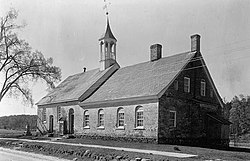Bethabara, North Carolina
|
Bethabara Historic District
|
|

Bethabara Moravian Church in 1934
|
|
| Location | North of Winston-Salem on NC 67, near Winston-Salem, North Carolina |
|---|---|
| Coordinates | 36°9′16″N 80°17′55″W / 36.15444°N 80.29861°WCoordinates: 36°9′16″N 80°17′55″W / 36.15444°N 80.29861°W |
| Area | 41 acres (17 ha) |
| Built | 1753 |
| NRHP Reference # | 78001948 |
| Significant dates | |
| Added to NRHP | November 15, 1978 |
| Designated NHLD | January 20, 1999 |
Bethabara Historic District encompasses the surviving buildings and archaeological remains of a small Moravian community, that was first settled in 1753. Located in present-day Forsyth County, North Carolina, it is now a public park of the city of Winston-Salem. It was designated National Historic Landmark in 1999.
Bethabara (from the Hebrew, meaning "House of Passage" and pronounced beth-ab-bra, the name of the traditional site of the Baptism of Jesus Christ) was a village located in what is now Forsyth County, North Carolina. It was the site where eleven men from the Moravian Church first settled in 1753 in an abandoned cabin in the 100,000-acre (400 km2) tract of land the church had purchased from Lord Granville and dubbed Wachovia.
Its early settlers were noted for advanced agricultural practices, especially their medicine Garden, which produced over fifty kinds of herbs.
Although later parties of Moravians joined the first eleven, including women and children, Bethabara was never meant to be a permanent settlement. It was intended to house the Moravians until a more suitable location for their central village could be found. In 1771, that place was completed: Salem. Many of the settlers moved to Salem, and Bethabara became an outlying farm to supply the residents of Salem and other Moravian villages with food.
In 1788, a slave, Johann Samuel, was named superintendent of the farm; he was freed in 1801, though he continued to rent the land from the church. However, the village of Bethabara, as it existed, was no longer needed, and it fell into disuse. The original buildings collapsed, and their foundations were filled in to make more farm land. Only the church and a few other buildings continued in regular use.
...
Wikipedia


